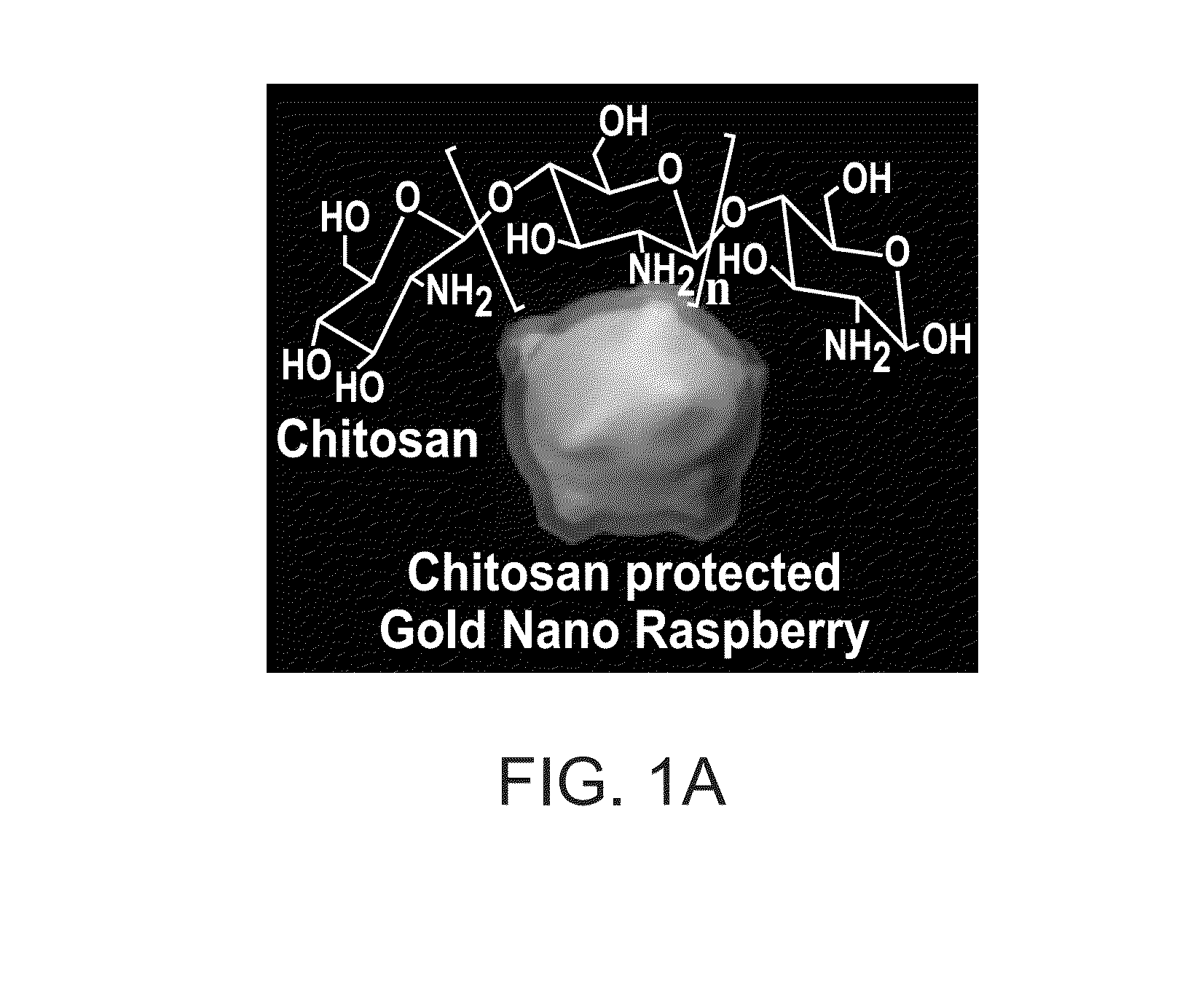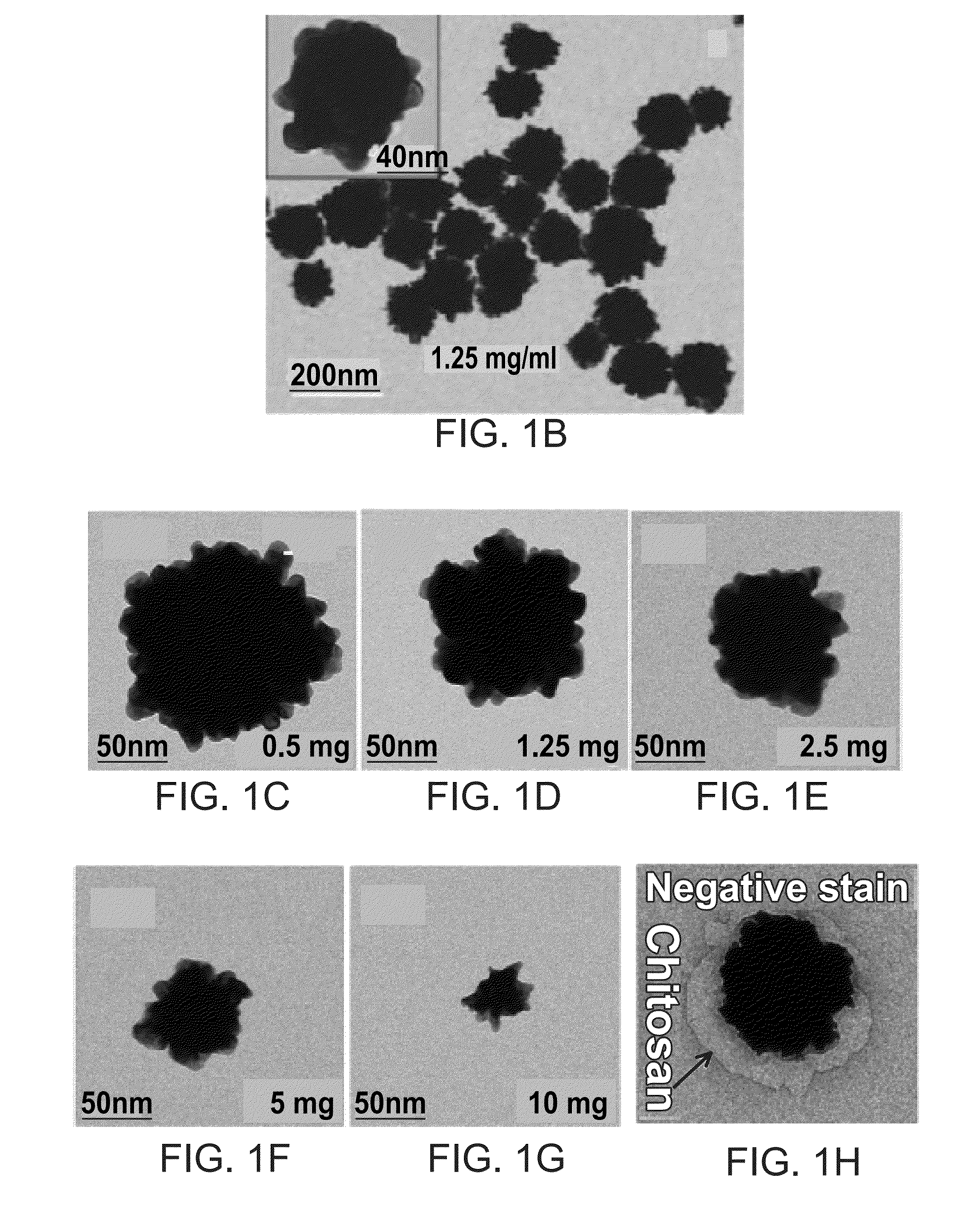Nanoraspberries for photothermal cancer therapy
a cancer therapy and nanoraspberry technology, applied in the field of nanoparticles for cancer therapy, can solve the problems of difficult to translate the majority of the nanotherapeutics to clinical applications, difficult to achieve the desired effect of nanoparticle uptake by cancer cells, and high cos
- Summary
- Abstract
- Description
- Claims
- Application Information
AI Technical Summary
Benefits of technology
Problems solved by technology
Method used
Image
Examples
example 1
Materials
[0073]All materials were used as received without any further purification. Gold chloride (HAuCl4.4H2O), ascorbic acid, chitosan (medium molecular weight), 1-ethyl-3-(3-dimethylaminopropyl) carbodiimide (EDC), N-hydroxysuccinimide (NHS), fluorescein isothiocyanate (FITC), Dimethylthiazol-2-yl)-2,5-diphenyltetrazolium bromide (MTT) and pencillin-steptomycin were purchased from Sigma-Aldrich (St. Louis, Mo., USA). Hydrochloric acid (HCl) was obtained from EMD (Gibbstown, N.J). Live / Dead Viability kit (Ethidium homodimer-1 and Calcein AM) and Trypsin-EDTA (0.25% 1×) were purchased from Life Technologies Corp. McCoy's 5A medium, MEBM medium, MCF-10A cells, and SKBR3 cells were purchased from ATCC. MEGM bullet kit to mix with MEBM medium was purchased from Lonza (Kit Catalog No. CC-3150). The formvar / carbon coated copper TEM grids were acquired from Ted Pella (Redding, Calif., USA). Nanopure water (>18.0 Mω-cm) was used for all experiments.
example 2
Synthesis of Chitosan Protected Gold Nanoraspberries
[0074]The chitosan solution used in the synthesis of gold nanoraspberries was made by dissolving 50 mg of medium molecular weight chitosan in 3 mL of water at pH 1.4. Once the chitosan was completely dissolved after vigorous sonication and vortexing, an additional 7 mL of water was added to the concentrated chitosan solution, resulting in a final concentration of 5 mg / mL. The pH of the chitosan solution at this stage was about 6.0. 200 μL of the chitosan solution (5 mg / mL) was then added to 800 μL it of water and the solution was homogenized by vortexing the solution. To this chitosan solution (1 mg / ml), 100 μL of gold chloride (4.86 mM) solution was added. The resultant solution was homogenized thoroughly to ensure the uniform solution. 50 μL of ascorbic acid (0.1 M) was added to the above reaction mixture under vigorous stirring (1200 rpm) for 30 seconds. The solution was left undisturbed for overnight to form gold nanoraspberrie...
example 3
FITC-Conjugation
[0077]1 mL of 10 μmol fluorescein sodium salt (FITC) solution in water was activated with 10 μmol 1-Ethyl-3-(3-dimethylaminopropyl) carbodiimide (EDC). Then 50% of free amines on chitosan (2 μmol of monomer concentration) were modified using 15 μmol of N-hydroxysuccinimide and 10 μmol of activated FITC. Then the pH of the reaction was slowly adjusted to about 6.5 and the reaction was left overnight. Subsequently, the pH of the reaction was adjusted to basic (about 9) to precipitate chitosan-GRBs and washed 5 times to completely remove the free FITC. Then FITC-GRBs conjugation was confirmed by UV / Vis and FT-IR (FIG. 11).
PUM
| Property | Measurement | Unit |
|---|---|---|
| Fraction | aaaaa | aaaaa |
| Fraction | aaaaa | aaaaa |
| Fraction | aaaaa | aaaaa |
Abstract
Description
Claims
Application Information
 Login to View More
Login to View More - R&D
- Intellectual Property
- Life Sciences
- Materials
- Tech Scout
- Unparalleled Data Quality
- Higher Quality Content
- 60% Fewer Hallucinations
Browse by: Latest US Patents, China's latest patents, Technical Efficacy Thesaurus, Application Domain, Technology Topic, Popular Technical Reports.
© 2025 PatSnap. All rights reserved.Legal|Privacy policy|Modern Slavery Act Transparency Statement|Sitemap|About US| Contact US: help@patsnap.com



